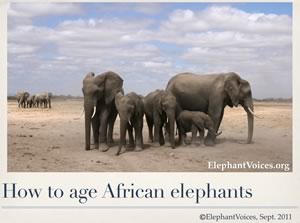Mara Elephants Who's Who & Whereabouts
 Identifying elephants isn't difficult, but it requires using powers of observation and it takes a bit of practice. There are many different characteristics that you can use to identify an elephant: sex; body size; shape; length and configuration of the tusks; size and shape of the ears; ear venation patterns; notches, tears, holes in the ears. ElephantVoices has developed eight educational modules explaining how to read and understand these characteristics, also used in the Mara Elephants Who's Who database.
Identifying elephants isn't difficult, but it requires using powers of observation and it takes a bit of practice. There are many different characteristics that you can use to identify an elephant: sex; body size; shape; length and configuration of the tusks; size and shape of the ears; ear venation patterns; notches, tears, holes in the ears. ElephantVoices has developed eight educational modules explaining how to read and understand these characteristics, also used in the Mara Elephants Who's Who database.
You should start by determining whether the elephant you are trying to identify is male or female, and will get help from How to sex African Elephants.
It helps to be able to put the elephant you are trying to identify into a size category. Size categories correspond to rough age ranges. The size categories we use are: Calf (0-4 years), juvenile (5-9 years), small adult (10-19 years), medium adult (20-34) and large adult (35 years+). Putting elephants into size classes takes a bit of practice and we don’t recommend using this characteristic to identify elephants until you have a lot of experience.
By clicking on the screenshot above right, or on links to photos below, you will start a slideshow - the caption shown is equal to respective text on this page. You can go through slide by slide - or let it run through automatically. Learn more about elephants - enjoy!
What to look for to find the age of an African elephant (Start slideshow)
- Remember that adult males grow to be twice the size of adult females so the relative sizes of small adult, medium adult and large adult are different depending upon which sex you are considering. Photo B1
- For example, by age 17 a male is a large as a 50-year-old female, so a small adult male may be larger than a large adult female. Young males lined up to drink - a full grown female on the far right. Photo B2
- We use the term infant for a calf under a year old. An infant has no tusks and is generally small enough to walk under the belly of a large adult female. The genitals must be used to sex an infant. Photo B3
- A calf's tusks appear just beyond the lip between 18 months and two years old. Rely on genitals to sex the calf. Photo B4
- By three years of age a calf's tusks extend about 8 cm beyond the lip. At this age, if the calf is a female, you may notice a slight knob on her forehead; but the genitals are still definitive for sexing. Photo B5
- Relative sizes of three calves from left to right: Two and a half year old, one-year-old, and four-year-old female (note the slightly pointed forehead and tusks about 10 cm long). Photo B6
- Relative sizes from left to right: Calf under age two, juvenile female (note pointed forehead and slender tusks) and young adult female (note pointed forehead and slender tusks). Photo B7
- Relative sizes in a family from left to right: Calf under age two, medium sized adult female, juvenile female (note slender tusks), infant, young adult female. Photo B8
- Relative sizes in a family unit from left to right: juvenile, calf, young adult female, young adult female, juvenile, juvenile, medium adult female, infant, medium adult female. Photo B9
- Relative sizes in a family from left to right: juvenile female, medium adult female, calf, juvenile female, small adult female, juvenile female, medium adult (with infant underneath her) calf, medium adult female, calf, small adult female, infant, juvenile, juvenile, large adult female. Photo B10
- Mother and daughter: note that the older female has a larger body, a relatively larger head and thicker tusks. And she just looks older. Photo B11
- Large adult females have relatively large heads, thicker tusks, longer bodies. The oldest females may become sway-backed. Photo B12
- Adult males and large adult females stand out in a crowd. Spot them! Photo B13
- An adult male dwarfs an adult female and her juvenile daughter. Photo B14
- By age 17 males are as big as a large adult female, yet only half the weight of a large adult male. Small adult males have relatively small heads, relatively thin tusks and the line from their eyes to their tusks is straight. Photo B15
- Small adult males have relatively small heads, relatively thin tusks and the line from their eyes to their tusks is straight. Photo B16
- Medium adult males have larger heads than small adult males and relatively thicker tusks. As the forehead expands and the tusks thicken, the line from the eye to tusk begins to curve. Photo B17
- Another medium adult male. Again notice that he has a larger head than small adult males and relatively thicker tusks. Photo B18
- Large adult males have massive heads and thick tusks that bulge out from the face. The wide forehead and ticker tusks create a line from eyes to tusks that has an hourglass contour. They have heavy muscular bodies. Photo B19
- Another large adult male. Notice again his massive head and big tusks. Photo B20


